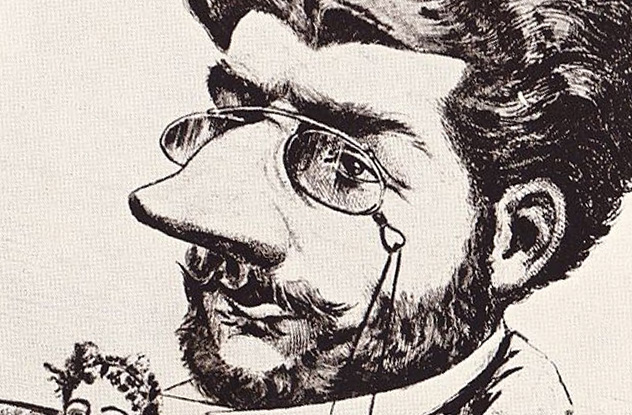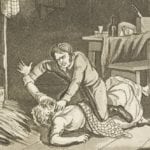 Technology
Technology  Technology
Technology  Humans
Humans 10 Everyday Human Behaviors That Are Actually Survival Instincts
 Animals
Animals 10 Animals That Humiliated and Harmed Historical Leaders
 History
History 10 Most Influential Protests in Modern History
 Creepy
Creepy 10 More Representations of Death from Myth, Legend, and Folktale
 Technology
Technology 10 Scientific Breakthroughs of 2025 That’ll Change Everything
 Our World
Our World 10 Ways Icelandic Culture Makes Other Countries Look Boring
 Misconceptions
Misconceptions 10 Common Misconceptions About the Victorian Era
 Mysteries
Mysteries 10 Strange Unexplained Mysteries of 2025
 Miscellaneous
Miscellaneous 10 of History’s Most Bell-Ringing Finishing Moves
 Technology
Technology Top 10 Everyday Tech Buzzwords That Hide a Darker Past
 Humans
Humans 10 Everyday Human Behaviors That Are Actually Survival Instincts
 Animals
Animals 10 Animals That Humiliated and Harmed Historical Leaders
Who's Behind Listverse?

Jamie Frater
Head Editor
Jamie founded Listverse due to an insatiable desire to share fascinating, obscure, and bizarre facts. He has been a guest speaker on numerous national radio and television stations and is a five time published author.
More About Us History
History 10 Most Influential Protests in Modern History
 Creepy
Creepy 10 More Representations of Death from Myth, Legend, and Folktale
 Technology
Technology 10 Scientific Breakthroughs of 2025 That’ll Change Everything
 Our World
Our World 10 Ways Icelandic Culture Makes Other Countries Look Boring
 Misconceptions
Misconceptions 10 Common Misconceptions About the Victorian Era
 Mysteries
Mysteries 10 Strange Unexplained Mysteries of 2025
 Miscellaneous
Miscellaneous 10 of History’s Most Bell-Ringing Finishing Moves
10 Bizarre Fads From The Early 20th Century
Planking. Tebowing. The Harlem Shake. They’re all part of our modern pop culture. They come in, entertain us for five minutes, and then vanish, never to be heard of again. People do all kinds of stupid things so you can watch their videos online, so critics see these fads as a negative, new part of our society. But the truth is that fads like them have been around for quite a while now.
10Goldfish Swallowing
Very few fads have any staying power, but some of them can remain popular for decades. Streaking, for example, is just as popular today as it ever was. Goldfish swallowing might not be as big, but it still has a loyal following, and enthusiasts can even go online and see others perform the Goldfish Challenge.
As far as what this fad actually entails, no further explanation is necessary. The name says it all. Seeing people eat weird stuff might repulse us, but, for some reason, we can never look away. What’s truly impressive about this silly fad is that it started in 1939 and it’s still going strong. It all began with a Harvard freshman named Lothrop Withington Jr., who swallowed a live goldfish for a $10 bet. Surprisingly, this wasn’t some stupid drunken dare. Withington trained for the event by swallowing smaller fish until he made his way to the finger-length goldfish.
As it happened, a photographer was on hand to record the occasion. People weren’t really expecting this to become anything more than a silly yearbook photo, but it spread from campus to campus and even got featured in Life magazine. Others soon started one-upping Withington’s feat, downing dozens of goldfish at once. The unofficial record belonged to John Deliberato from Clark University, who swallowed 89 goldfish in one sitting. It got so bad that a senator filed a bill to prevent “cruel and wanton consumption” of fish on college campuses.
9Phone Booth Stuffing
We really like to take small, confined spaces and shove as many humans as possible inside. It does make for a pretty good photo op, and it all started with a gang of students in Durban, South Africa, in 1959. For whatever reason, they decided to shove 25 students inside a phone booth and take a picture. They later submitted their feat to the Guinness Book of World Records. From there, the practice started making its way through Europe and America.
That same year, a group of students at St. Mary’s College in California heard of the record and wanted to beat it. They didn’t succeed, squeezing only 22 people inside their booth, but they did benefit from the added presence of Life magazine photographer Joe Munro on scene to snap a few shots. After the image of the college students stuffed inside a phone booth made it onto the newsstands, the practice really took off.
People soon realized that humans could be shoved in all sorts of places, not just phone booths, so spin-offs in cars, trains, buses, and even outhouses soon appeared. And the practice remained popular throughout the decades. Just a few years ago, a new record was set for most people in a photo booth.
8Hunkerin’

Pretty soon after the phone booth stuffing craze, America found its new fad—hunkerin’. The goal—simply to squat on the balls of your feet for a long time. People with imagination would look for unusual places to hunker, so it was a precursor to owling. The most important thing was to make sure you weren’t doing it alone—hunkerin’ was a team activity. The more advanced participants could engage in “hunkerin’ and hookin’,” which meant squatting and drinking beer at the same time.
This fad allegedly originated at the University of Arkansas due to a shortage of chairs. The name came from the Scottish word for “haunches.” Students saw it as a good way to bond, whether they were hunkerin’ over a few drinks or during a study session. They even came up with numerous different hunkerin’ styles. The outside hunker, for example, meant keeping the elbows outside the knees while the friendship hunker involved resting your arms on the people to your right and left.
As far as fads go, this one was pretty bland. How much entertainment could you get out of just squatting and sitting still? Even so, campus authorities preferred it over phone booth stuffing because it was more relaxed. Unsurprisingly, this was one of those fads that were soon forgotten as people moved on to the next one.
7Pole Sitting
If you want something that combines excitement with the comfort of sitting down, try pole sitting. Just climb atop a flagpole and stay there as long as possible. Like with modern planking, the appeal of pole sitting comes from people in unusual places. However, while planking lasts just long enough to take a picture, pole sitting is a feat of endurance, and people stay in position for days on end.
The practice was started by a stuntman named Alvin “Shipwrecked” Kelly. He first did it in 1924 as a bet and lasted for over 13 hours. As the feat garnered quite a bit of media attention, he was hired to do it for publicity stunts. Many people started imitating him soon afterward, including 15-year-old Avon Foreman, who set a record of 10 days and 10 hours.
Kelly’s personal best was 49 days, but that was nothing compared to Richard “Dixie” Blandy who took pole sitting to the extreme. His first experience came in 1929, when he sat on a flagpole at a gas station for a publicity stunt. Four years later, he set a new record by sitting for 77 days on a flagpole at the Chicago World Fair. At the Michigan State Fair in 1954, he set a flagpole standing record of 10 days, and in 1960, he pedaled a bicycle atop a pole for a record 13 days. He would go on to break his own record two times, the last time sitting 125 days on a pole in Stockholm. He died aged 72, when the pole he was sitting on in Chicago collapsed.
6TeddyBar Pictures

Part of the reason we found fads so bizarre is that they were not universal. Before the Internet, most fads were localized inside a country, perhaps even just a small region. The people living there understood how the fad got started, and to them, it made sense. Outsiders were left looking confused. For example, during the first half of the 20th century, Germans liked to pose for photographs with people in polar bear costumes.
The pictures in question come from a French collector named Jean-Marie Donat. They are dated between 1920 and 1960, so this was quite a long-lived fad in Germany. Donat spent 20 years of research to amass his collection, and even he is still not sure of the origins behind this fad. German toymaker Richard Steiff was partially responsible for creating the teddy bear, so it is possible that the bear was simply a beloved part of German culture.
The collection contains a lot of pictures with kids, people on holiday, people at the beach, weddings, and even some Wehrmacht officers posing with the polar bear.
5Six-Day Racing
Six-day racing is a feat of skill and endurance that was extremely popular during the first decades of the 20th century. Like the name suggests, riders had to race bicycles on an indoor track for six days. Although probably apocryphal, the story goes that six days were chosen so as to avoid having to do it on a Sunday.
Although six-day racing is usually considered an American pastime, it originated in England during the late 19th century. The first record race took place in London in 1878. However, it wasn’t until the sport migrated to America that it started gaining increased exposure. After six-day racing became huge in the United States, it migrated back throughout other parts of Europe.
The rules for six-day racing changed over the decades. Originally, in England, riders were limited to 18 hours of racing per day. When it came to America, it turned into a six-day nonstop event. This extreme form of racing meant drivers doped to stay awake, experienced hallucinations, and crashed a lot (which only made the sport more popular). Some safety regulations were eventually introduced that only allowed drivers to race for 12 hours at a time, which turned the event into a team sport.
Six-day racing was huge in the 1920s and 1930s. Events were regularly scheduled at Madison Square Garden, where celebs like Bing Crosby and Jack Dempsey came out to witness the spectacle and cheer on the “stars of the saucer.”
4Panty Raids

A lot of fads of the 1930s like goldfish swallowing and six-day racing saw their popularity diminish drastically thanks to World War II. Then, after the war, came a period of calmness as people eagerly anticipated what would become the next big thing. In 1949, they got their answer—college boys breaking into the girls’ dorms and making off with their underwear.
Most of us are familiar with panty raids from college movies, but they reached the peak of their popularity in the 1950s. The first instance of this happening was in 1949 at Augustana College in Illinois. The goal there was not to steal underwear, but just to cause general commotion. However, some pranksters made off with a few pairs of lingerie, and the term “panty raid” was used by the press.
Thanks to the extensive coverage by the media, panty raids become a popular college prank all over the nation. By 1952, it was an “epidemic” plaguing over 50 different universities. College kids were not deterred even though they risked expulsions, arrests, and even tear gas attacks on several occasions. The female students were usually aware of the raids and sometimes even assisted the boys. This was more about rebelling against authority and sexual repression than it was about college kids being little pervs. The University of California, Berkeley, holds the dubious honor of “largest panty raid”—in 1956, over 2,000 students took part in a panty raid that caused over $20,000 in damages.
3Kilroy Was Here

A war might be a strange source for fads, but soldiers need some way to entertain themselves, too. That is why “Kilroy was here” appeared during World War II. The piece of graffiti showed a bald man with a long nose sticking his head over a wall. It was simple, easy to draw, and lighthearted enough to become a popular recurring joke that endured even once the war was over.
Although Kilroy was firmly associated with America GIs, it was inspired by an older British drawing known as Mr. Chad. Chad, allegedly the 1938 creation of British cartoonist George Chatterton, also poked his bald head over the wall and said “Wot? No tea?” (Tea was substituted with sugar, tobacco, or whatever else was in short supply.)
By the end of the war, there were thousands of “Kilroy was here” drawings all over Europe and America, so this was clearly the work of thousands of soldiers, not just one guy bored out of his mind. But was there ever a real Kilroy? More than one person came forward as the real Kilroy, but the generally accepted origin is one James J. Kilroy, a shipyard inspector during the war. He had a habit of scribbling “Kilroy was here” in crayon on ships that passed inspection. In 1946, the Transit Company of America held a contest to find the real Kilroy, and James provided them with enough evidence to claim the prize, his very own trolley car.
2Face Book

That’s “face book” and not Facebook, as the former preceded the latter by over 100 years. At least, that’s what historians discovered when they were digitally archiving century-old newspapers from the Boston Daily Globe. One of them from August 24, 1902, had the headline “Face Book the New Fad.” Back then, a face book was a lot more literal—it was a book where people would draw faces.
Face books were a popular social game at the beginning of the 20th century. People would gather at parties and draw caricatures of each other, and these would be bound together and collected in a book, usually made out of heavy, white linen. A particularly good drawing would usually be accompanied by a few witty lines. Face books allowed friends to share drawings, jokes, and pictures with each other, so it was a bit like our modern equivalent, just far less technological.
This wasn’t the first foreboding article found by the team of archivists. They previously uncovered a 1942 article from the Washington Post titled “Think before You Twitter” about people being not being thoughtful of others.
1Tijuana Bibles

During the Great Depression, people needed cheap sources of entertainment. That’s where Tijuana Bibles came in. Also known as eight-pagers, these were palm-sized, humorous, pornographic comic books. Although they appeared during the 1920s, their popularity soared during the 1930s and 1940s. They got passed around from person to person in speakeasies, pool halls, dance halls, and everywhere else large groups of men gathered.
The name came from the incorrect belief that the comic books were made in Tijuana and imported into the United States. Most of the artists behind them were American but remained anonymous. One of the most successful Tijuana Bible creators was known simply as Mr. Prolific, and Wesley Morse, creator of Bazooka Joe, was heavily rumored to have drawn a few himself.
The Tijuana Bibles parodied popular characters of the day. This included comic book characters like Popeye (who appeared in more eight-pagers than anyone), Blondie, and Dick Tracy, as well as real people like Jack Dempsey and Al Capone. Actors and actresses were popular choices. Greta Garbo and Joan Crawford were frequent protagonists, although Mae West was the Queen of the Tijuana Bibles, where, for some odd reason, she was usually paired up with Popeye.
Radu is a history/science buff with an interest in all things bizarre and obscure. Share the knowledge on Twitter or check out his website.








